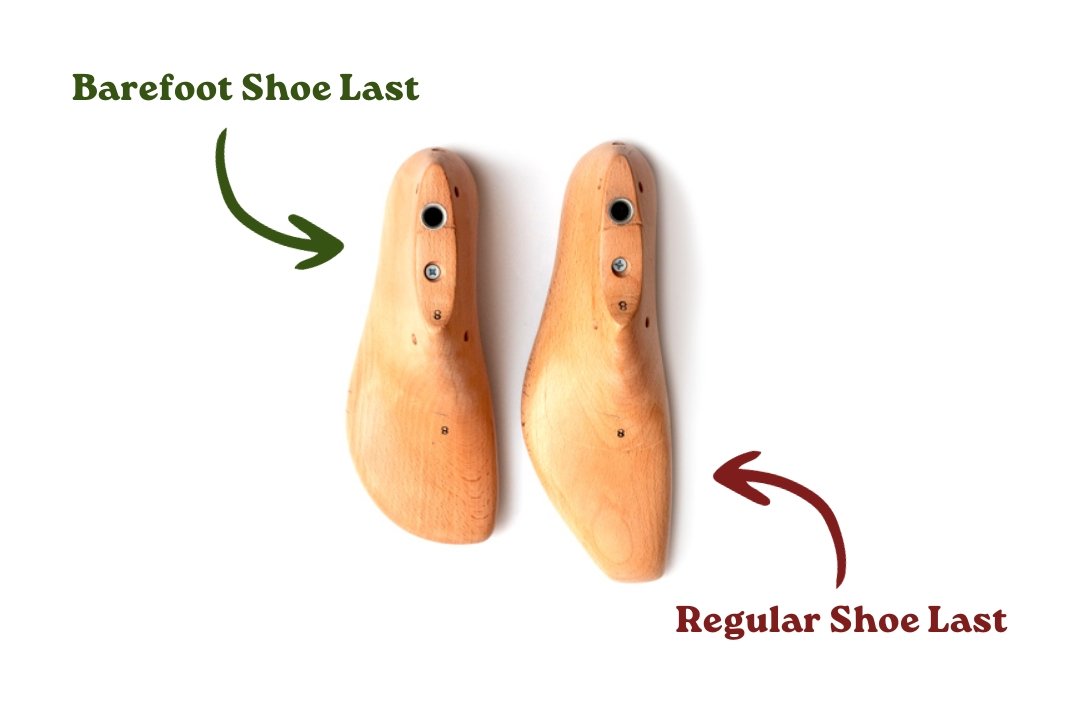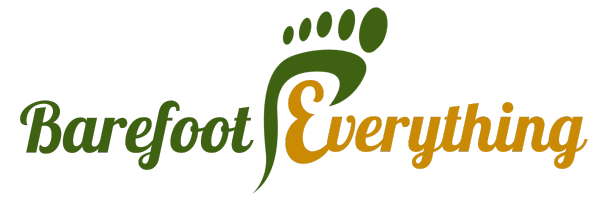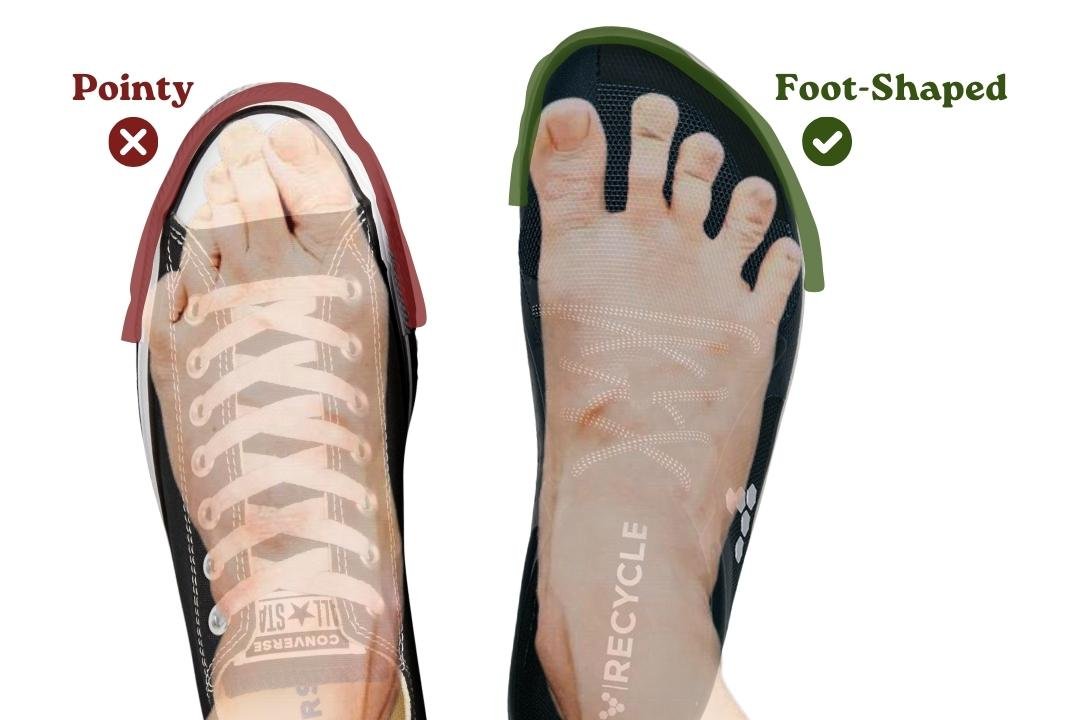Key Takeaways
I’ve spent hundreds of hours researching and testing barefoot shoes. Let nobody lie to you - their benefits don’t come without trade-offs.
They’re pricey, some are rather ugly, they’re hard to come by in stores, and wearing them might sometimes hurt your foot more than help it.
With that said, I love them!
Over time, barefoot shoes can improve your foot health and get you closer to nature. But whether they’re suitable for you or not is a personal decision that requires understanding their trade-offs.
To help you make an informed decision, here’s my detailed rundown of the pros and cons of barefoot shoes so you don’t regret your purchase later. Enjoy!

Infographic summarizing barefoot shoes pros and cons.
The Pros of Barefoot Shoes
Strengthen your feet
Feet are the base of your body. If they’re weak, your knees fall apart, your posture crumbles, your back and shoulders start hurting, and you get injured more often.
Nearly every health benefit of barefoot shoes stems from your feet simply becoming stronger.
Regular shoes have raised heels, cushioned soles, and arch supports. Because of that, the feet don’t need to work as much, and they get lazy.
Over time, the intrinsic muscles in your feet weaken, and your feet’s range of motion decreases. That causes problems like overpronation and oversupination, increasing the likelihood of injury.
If you take your health seriously, this reason alone should be enough to consider putting on barefoot shoes at least a couple of days a week.
Improve balance and stability
While all that soft cushioning in regular shoes makes them more comfortable, it forces your feet to balance on what is essentially a sponge, which is a difficult task.
Don’t believe me? Try balancing on one foot for 30 seconds, once in your shoes and once without. Which one was easier?
The sole of barefoot shoes is flat and flexible, providing a better sense of the surface, so your feet can adjust your balance more immediately.
If you regularly work out in the gym, you'll especially appreciate the benefits of zero-drop heels and foamless soles. When you don’t need to waste energy trying to keep your feet flat on the floor, you can direct it to improve your lifts and form.
Even if you never work out, how often have you twisted your ankle painfully or even fell in seemingly random places? Yeah. I can guarantee you wouldn’t have if you were going barefoot.
Improve posture
If you stood perfectly straight in high-heeled shoes, you would fall over.
Almost all shoes have at least an 8mm heel raise, and your body needs to compensate somewhere to keep you upright. Over time, this can cause various pains in the posterior chain. Barefoot shoes solve that with zero-drop heels.

Rossi, William A. "Why shoes make “normal” gait impossible." Podiatry Management 3.1999 (1999): 50-61.
Here’s a quick test for you - stand up on your toes with your shoulders square and legs straight.
See how much your lower back and glutes must work to keep you standing? If you relax, your pelvis tilts forward to keep you balanced. That is both unhealthy and unsightly.
This pelvic tilt also occurs when you wear regular shoes. Only a tiny amount of it, yes. But that makes it even worse because the associated lower back, shoulder, and neck pain creeps up on you seemingly out of nowhere.
Reduce the risk of foot deformities
Bunions, hammer toes, ingrown nails - all result from the poor design of regular shoes.
Shoemakers have long abandoned common sense in favor of fashion, so we’ve accepted that narrow, pointy toe boxes and raised heels are standard. However, squishing your toes together and forcing them into unnatural positions for long periods is far from natural.
Barefoot shoes are made using a different kind of shoe last that follows the natural shape of your feet. They have a wider toe box, so your toes don’t need to contort to adapt to the abnormally pointy shoe.

On the right - that's not what a normal foot looks like.
Over time, poorly fitting shoes can make your feet look deformed and unsightly and even cause painful conditions requiring surgery.
Improve comfort
Mainstream shoe brands will want you to believe that the cushioning makes your shoes comfortable. That is false.
Sure, it feels like you’re standing on a cloud at first, but after a while, your foot muscles fatigue from balancing on an unstable surface.
Additionally, when your feet get warmer, they expand, amplifying the pressure against the narrow and rigid shoe walls. That constricts your blood flow, and your feet go numb and cold.
Barefoot shoe makers have figured it all out, and they make their shoes’ toe boxes wider and materials flexible, significantly improving your comfort. You will especially appreciate the extra wiggle room for toes on long travels.
Increase sensory feedback
Our feet are supposed to feel the surface we’re walking on. That’s why they have so many nerve endings.
The soft grass, rocks, or sand textures offer pleasant sensations. Yet, we’re adamant about adding an inch of padding between our feet and the ground, leaving us feeling nothing.
Barefoot shoes have thin soles, which allows you to better feel the surface you're walking on.
Of course, pavement might not be the most exciting surface, but if you’re into hiking in nature, you must own a pair of barefoot shoes.
Even if you’re a complete urban dweller, this feeling of the ground will be valuable when doing sports or working out because it will allow you to be more agile and maintain better form.
Encourage more efficient gait and running form
Have you ever wondered why shoes need all that cushioning in the first place?
The inflexible traditional shoe with a raised heel interferes with the natural gait, making you step heel-to-toe. Continuously hitting your heel on a hard surface is painful and, over time, damages your feet, knees, and hips. That’s why shoemakers started adding cushioning to the heel.

The problem is that cushioning creates an illusion of lower impact on your joints - you don’t feel the effect immediately, but it doesn’t mean there isn’t any. That’s the reason so many habitual joggers suffer knee pain.
Barefoot shoes force you to adapt your stride to a more healthy one because when you run in them, you immediately feel how painful and unnatural heel-to-toe running form is and switch to shorter strides and a forefoot strike. In fact, that’s how we are supposed to walk and run naturally.
Therefore, barefoot shoes bring us closer to the correct, more efficient gait and running form.
Promote sustainability
Most barefoot shoe companies take their environmental impact particularly seriously.
Their primary audience is people who are mindful of their health and view themselves as outdoorsy, close to nature, eco-conscious, and minimalist. That’s why barefoot shoe companies tend to be more progressive regarding sustainability.
Here are only a few examples:
- Bohempia makes vegan, 100% biodegradable shoes from hemp using only solar energy.
- Xero shoes live by the principles: Build it to Last, Use Less, and Source Better.
- VIVOBAREFOOT supports environmental initiatives and has strict requirements for the materials and partners they work with. They also offer to refurbish your shoes or dispose of them in an eco-friendly manner.
So, if you care about our future, consider switching to barefoot shoes and helping responsible companies become mainstream.
The Cons of Barefoot Shoes
Potential of injuries while transitioning
The internet wants you to believe that barefoot shoes will magically solve all your foot problems, but I’m sorry to disappoint.
Barefoot shoes will highlight all your gait and foot deficiencies and exacerbate pre-existing pains.
If you weren’t regularly walking barefoot before, the lack of cushioning can cause discomfort initially, and you might even get injured if you don’t give your feet time to adapt.
However, any pains should go away after a brief transition period as your foot muscles and tendons strengthen and adjust to the more natural way of walking.
Still, it’s a good idea to ease into barefoot shoes gradually and regularly do some foot exercises to regain lost mobility.
Pricey and durability can be questionable
Barefoot shoes are a niche product which brings a unique set of problems for their manufacturers:
- Non-standard molds and shoe lasts;
- Unusual manufacturing techniques;
- Higher specialized labor costs in developed countries;
- Low order volumes.
Additionally, barefoot shoes face higher material costs because they need to be more flexible, durable, and sustainable. That often drives their retail price up well into the hundreds.
Because there aren’t any proven templates shoe companies can follow to solve those challenges, they must constantly innovate, and sometimes, they miss the sweet spot.
For instance, the thin sole might get worn out more quickly, or the shoes might sometimes come with uneven stitching or glue residue.
To avoid wasting money on expensive shoes you’ll later regret purchasing, check out our reviews of the brands and shoe models before buying.
Unusual or straight-up wacky look
You will not win any fashion contest wearing barefoot shoes.
Wider toe box will make your feet look larger, so much so that people sometimes call them “clown shoes.” I can attest to that as someone who already has disproportionally large feet.
Not to mention that some models like Vibram Five Fingers would be considered an abomination among fashionistas. If your only goal is to appear stylish, you should stick with regular shoes.

Here's what Vibram FiveFingers look like on your feet.
However, if you manage your standards, you can still find stylish models, and our shoe reviews will make it a lot easier for you.
Limited selection compared to traditional shoes
You might be disappointed if you need shoes for niche activities or extreme conditions.
Compared to the vast array of styles and designs available in the traditional shoe market, barefoot shoes come in fewer options. That is particularly noticeable when searching for specialized shoes for specific sports or activities.
There’s simply too little demand for minimalist waterproof or reinforced work shoes to justify creating a wide range of models, so your options will be limited.
However, there are plenty of options for everyday footwear or minimalist running shoes if that’s all you need.
Buying shoes becomes more of a hassle
Are you willing to sacrifice the convenience of simply going to a physical shoe store, trying on a couple of pairs, and walking out of the store in new shoes? Because that’s what you’ll do.
From the day you switch to barefoot shoes, you’ll have to order them online because few physical stores sell them. That means dealing with postage, delays, and returns in case they don’t fit.
Additionally, sizing minimalist shoes is more difficult because you’ll need to measure your foot and be mindful of whether its shape is compatible with the shoe you’re interested in.
If foot health is essential to you, all this will be a worthwhile trade-off, but knowing what you’re getting into is crucial.
Less protection against sharp objects
Walking over nails or broken glass isn’t exactly what barefoot shoes are for.
They have a thin sole, and the shoes must be flexible, so naturally, they offer less protection. That is precisely what makes them healthy and more natural everyday footwear, but they’re not the most resilient work shoes.
Still, they’re good enough for regular city life or hiking in nature, as walking over sharp rocks won’t pierce your foot.
You’ll need to learn to walk and run differently
The people who have the most problems with barefoot shoes are those who are not willing to adapt to the new gait requirements.
You can’t walk or run the same way as when you had all that extra padding in regular shoes and expect to be free of knee and hip pain - you must adapt your stride.
Luckily, walking and running in minimalist shoes is a matter of following these simple tips:
- Point your toes directly straight when walking;
- Make your stride shorter by putting your feet under rather than in front of you;
- Don’t slam your heel, and when you run, land on your mid-foot or forefoot;
Most importantly, listen to your body and don’t force anything.
If, after reading about the advantages and disadvantages of barefoot shoes, you’re interested in getting a pair, I recommend going over our guide first to avoid any pitfalls when choosing and buying minimalist shoes.
My Personal Take
I have been flat-footed for as long as I can remember. My feet were falling inward, and it was affecting my whole body:
- My legs were developing unevenly;
- My spine was getting twisted as a result;
- My shoulders were hurting.
The podiatrist told me to get expensive supination insoles, which did not solve anything but made my shoes extremely uncomfortable and hurt my arch. What actually helped was:
- Doing Karate - it's a barefoot sport and really strengthened my feet and body;
- Getting wider shoes.
Now, because I am flat-footed, my feet are a little wider than usual, so I usually need to buy shoes one size larger. That means I get blisters more easily because I slide forward. Tip from my experience - never attempt to run 10km in oversized shoes unless you don't want to be able to step on your feet for the next two weeks.
Considering all this - barefoot shoes are the perfect shoes for me. I can get shoes my size, and my feet won't get numb. Additionally, the almost barefoot nature of those shoes strengthens my ankles and arch, so all my flat-footed problems go away.
Not everyone needs barefoot shoes, but they might be perfect for you, too.
FAQ
Whether barefoot shoes are “good” or “bad” depends on your goals.
They’re good if you want more natural footwear with potential health benefits and don’t mind the transition period. And traditional shoes might be better if you need protection against extreme conditions, convenience, or fashion.
Ultimately, it’s all about evaluating the trade-offs to find the right balance for your lifestyle and preferences.
The most significant disadvantages of barefoot shoes are:
- Transition period during which you may experience increased discomfort;
- Limited style options, especially for niche or specialized activities;
- Limited availability in physical stores;
- Steep price.
Yes, walking in barefoot shoes is good.
Barefoot shoes will strengthen your foot muscles, improve balance, and provide better sensory feedback. Because of that, they’re especially great for hiking in nature. Some people may initially experience discomfort until their feet adapt, so it’s a good idea to transition to barefoot shoes gradually.
Yes, it’s good to run in barefoot shoes.
It’s an excellent alternative to barefoot running, offering adequate foot protection but maintaining natural movement. However, running form in minimalist shoes is different than traditional shoes. To avoid injury, avoid heel-striking by shortening your stride and landing on the balls of your feet instead.
No, barefoot shoes aren’t a necessity, especially considering their price. You can achieve some of the same benefits by simply being barefoot more, avoiding unhealthy shoes like those with raised heels, and regularly doing foot exercises.


